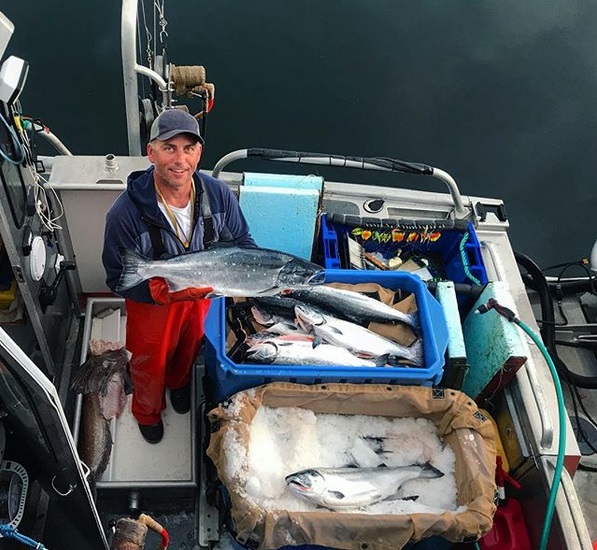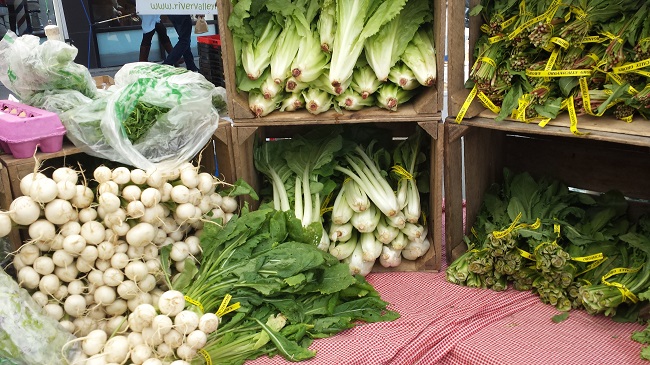SNAP SNAFU
This ain’t no way to run a railroad…or a nutrition program.
![]() (July 22, 2018) A little more than a week ago, we took notice of a story in the Chicago Tribune with the headline Some food stamp recipients may soon lose access to farmers market benefits. It reported that, as of July 31, an Austin-based company called The Novo Dia Group would stop processing Supplemental Nutrition Assistance Program (SNAP) transactions at about 1,700 farmers markets across the country.
(July 22, 2018) A little more than a week ago, we took notice of a story in the Chicago Tribune with the headline Some food stamp recipients may soon lose access to farmers market benefits. It reported that, as of July 31, an Austin-based company called The Novo Dia Group would stop processing Supplemental Nutrition Assistance Program (SNAP) transactions at about 1,700 farmers markets across the country.
The shutdown also will compromise a range of incentive programs that have emerged over the past decade to improve low-income shoppers’ access to healthful food. Nonprofit groups, such as Wholesome Wave and the Fair Food Network, and a $100 million U.S. Department of Agriculture program, the Food Insecurity Nutrition Incentive, match or supplement SNAP benefits at farmers markets.
“It’s devastating,” said Michel Nischan, CEO of Wholesome Wave, which offers matching dollars for SNAP spending at about 1,200 farmers markets. “There are markets in areas considered food deserts that are the only places to buy fresh food, and they only exist because patrons can use SNAP or incentives.”
As the USDA itself states on its SNAP web page, “SNAP is the largest program in the domestic hunger safety net.”
So how do you let the domestic hunger safety net suddenly acquire a massive hole?
Unfortunately, the answer to that question seems to be hidden–perhaps deliberately–under layers of technology, bureaucracy and perhaps politics. The official press release by the USDA Food and Nutrition Service sheds no light on the issue. But you need only look at this headline in Modern Farmer, USDA Responds to SNAP Issues at Farmers Market, But Does Not Clarify, to see that this particular turn of events is raising eyebrows in other quarters.
…here’s what happened: use of SNAP benefits (better known as food stamps) at farmers markets has been increasing more and more each year. But the system used to actually process the payments is supported by a middleman between the USDA and the markets. Until recently, that middleman was the Famers Market Coalition, but the USDA recently awarded the contract to a new middleman.
That middleman is a brand new and totally unknown company called Financial Transaction Management, LLC, (FTM) and it told the biggest processing companies that their technology will not be supported in the future. This means that those processing companies can no longer afford to offer their technology. Even more convoluted: FTM has yet to announce a replacement for those processing companies.
But wait–there’s more! In an earlier article, Modern Farmer provide information about the middleman, Financial Transaction Management, LLC.
In November 2017, that middleman contract came up for renewal. After months of deliberation, the USDA decided to replace them with a company called Financial Transaction Management, LLC, based in Reston, Virginia. Financial Transaction Management was formed in late October of 2017, just before the contract became available. It is listed on GovTribe as having one employee, Angela Sparrow, who did not respond to requests for comment. In April, Financial Transaction Management secured the USDA contract, which is worth $1.3 million.
Hmm. Anybody else getting a whiff of that fishy smell? Another part of the problem is that, as the Chicago Tribune reports above,
Markets can’t simply choose a new app, like Lyft instead of Uber. Novo Dia’s Mobile Market Plus software is the only one that works on Apple products and that also processes SNAP incentives. (Markets that do not use Mobile Market Plus must use two separate software systems.)
Now I’m getting a headache, too. Fortunately, there are two bits of good news. This first is this announcement:
The National Association of Farmers Market Nutrition Programs (NAFMNP) is providing Novo Dia Group operational funding for an additional 30 days so that stakeholder states will not experience any disruption in processing federal nutrition electronic benefits including SNAP…
The MobileMarket+ Select application developed by NDG was a cornerstone of MarketLink, and NAFMNP still believes that this platform has the potential to be a successful solution since it is the only one with the ability to accept all tender types, works on 4G networks, and is a mobile device solution that works for farmers markets and farmers. Since the inception of the MarketLink program, more than $40 million in sales (SNAP, credit & debit) has been processed through the NDG app via farmers markets and accepted by small farmers.
The second part of the good news is that the State of Illinois will be spared most of the pain associated with this screw up. Corey Chatman, who is the LINK Up Illinois Program Manager at the Experimental Station, writes in the blog on the Illinois Farmers Market Association (ILFMA) website,
Only 16 farmers markets accepting SNAP/Link in Illinois will be affected by this change. Most markets are using a standard SNAP/EBT wireless machine and not an Iphone/ Ipad based solution for SNAP transactions, which is the basis for the MarketLink platform. And, this does not impact the redemption of Link Match incentives. It will impact the ability (Nova Dia MarketLink merchants only) to distribute Link Match when the incentive is triggered by a SNAP sale. Check the brochure for the Illinois farmers markets accepting SNAP/Link in 2018.
Chatman joins us on the show this morning, as we ask why other states can’t follow the Illinois model, and we attempt to unravel why this happened in the first place. It’s all pretty byzantine, so wish us luck.
One more thing. Farmers Market Coalition has set up a GoFundMe page to raise money to purchase equipment for markets and farmers who will lose service because of the shutdown, which, as of now, will happen on September 1, 2018. They hope to raise $50,000 by the deadline.
However, I must comment. We are the richest, most powerful country in the history of the universe. Yet, we have to ask folks to rummage through their couch cushions for nickels and dimes to contribute to a fundraiser so that we can prop up a national food stamp program to help poor people buy fresh vegetables from farmers markets.
If that isn’t the definition of shameful, I don’t know what is.
Green Diva Meg introduces GD Spirit Pub (whatever that is)
Regular listeners to this show–all three of you, and I thank you from the bottom of my tiny heart for that–are familiar with Green Diva Meg, if only because of her weekly reports on The Mike Nowak Show with Peggy Malecki, which are called “Just a GD Minute” (one of the best titles ever for anything).
 Not too terribly surprising, Meg is the founder, accountant, janitor, chief announcer and a lot more for The Green Divas. She describes it as
Not too terribly surprising, Meg is the founder, accountant, janitor, chief announcer and a lot more for The Green Divas. She describes it as
an international media brand and go-to source for people in search of fresh ideas for sustainable living. We’re committed to raising awareness about issues related to climate change, health and social justice in a humorous (whenever appropriate and sometimes when it’s not), low-stress way and making it easy for anyone to live a greener lifestyle.
That certainly puts her in the wheelhouse of this show. Now, in addition to her TV segments, blog, podcasts and more, she’s added a slice of her personal life, which she calls “GD Spirit Pub.” It’s co-hosted by her lifelong friend, “Weenie Greenie Julie” Bond Genovese, who is an inspirational speaker, creative soul coach, workshop leader, artist, unschooling mom and best-selling author of award-winning memoir, Nothing Short of Joy. It’s kind of difficult to know what it’s about, because they just did the pilot, so we’ll wait and see.
Meanwhile, Meg, Peggy and I will probably discuss some of her other podcasts, including one that is called “Your Garden To-Do List for July” and anything other green topic that seems fun.
Sitka Salmon Shares and the quest for sustainability
If you listen to the The Mike Nowak Show with Peggy Malecki on the radio, or watch us on the live Facebook stream or visit www.mikenowak.net, you are aware of Sitka Salmon Shares. We’re very pleased that they are a sponsor for the program, so go to their website and get CSF share from them right now! You can get $25 off any 2018 purcahse by using the code mikenowak18. But I digress.
If you’re not familiar with the acronym CSF, that stands for Community Supported Fishery. It’s basically the same as a CSA–Community Supported Agriculture–but with fish instead of land-based farm food. And just like with CSAs, there are benefits to purchasing shares, just as there are challenges to both the consumer and the businesses.
For instance, just a month ago, the healthyish blog on the BonAppetite.com site had some great advice.
Trying to buy sustainable seafood generally means falling down a wormhole of charts, ranking systems, and misinformation. Recently, an AP investigation alleged that popular online seafood purveyor Sea to Table misled customers regarding its sourcing and supply chain transparency, among other claims (Sea to Table has refuted several of these allegations.) To better understand how consumers should seek out sustainable seafood options, we turned to Sheila Bowman, Manager of Culinary & Strategic Initiatives for the Monterey Bay Aquarium’s Seafood Watch.
“Take the lessons that you know from the farmers’ market and apply them to fish,” says Bowman. “Eat what’s seasonal and available and you’ll get a better product than demanding tuna in the middle of winter.” Seafood Watch has an app that provides up-to-date seafood recommendations, season by season, to keep you informed at the fish counter.
 Dr. Nicolaas Mink, Chief Executive Officer of Sitka Salmon Shares, had his own thoughts about the difficulty of selling and consuming food responsibly.
Dr. Nicolaas Mink, Chief Executive Officer of Sitka Salmon Shares, had his own thoughts about the difficulty of selling and consuming food responsibly.
Venture capital demands exponential growth—usually something like 10* in 3 years. Venture capital then seeks to extract all that value from the company that undergoes that growth (and the nature and labor that made that company possible) as gains for investors. I can think of few things more troubling for our modern food movement or food system than it being fully captured by venture capital. Sadly, that seems to be the way it’s heading. Exponential growth is anathema to healthy and thoughtful natural resource development and certainly doesn’t lend itself to thoughtful labor practices or relationships with producers. For oceans, especially, the strain that exponentially growing markets put on fisheries resources is why we have management in the first place.
How many of you ever consider that while you’re dipping your fried fish into the cup of tartar sauce? To bring it even closer to home, he adds this:
But this can be tricky business, mostly because of the way modern industrial capitalism has trained consumers to expect their food system to work. Consumers (be they chefs, grocery stores, or home cooks) now expect consistent, predictable, uniform cheap food that meets a certain aesthetic and is delivered at an astounding scale. This is something that’s tough for small-scale agriculture to accomplish, but the dynamism of regional fish populations, weather, tides, fishing culture, finance, and regulatory caprice all combine to ensure there is virtually no possible way for the systems that ungird fisheries, especially small-scale ones, to neatly satisfy these expectations.
I strongly suggest you read his entire blog to get a sense of the challenges facing CSFs and CSAs today. Mink joins us on the show this morning. I hope you tune in or catch the podcast at www.mikenowak.net/podcasts.


